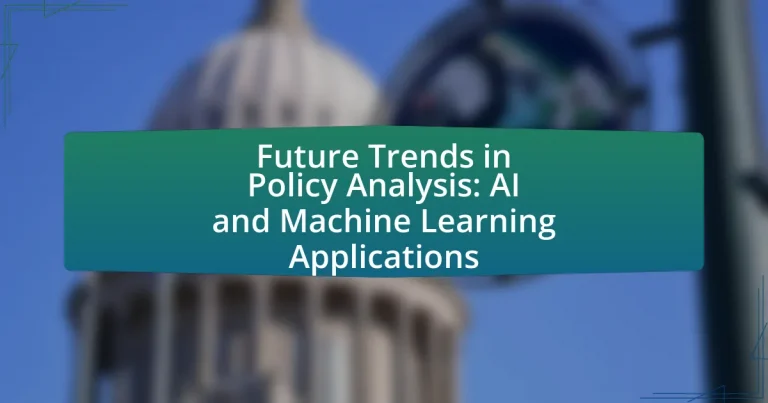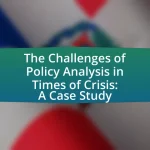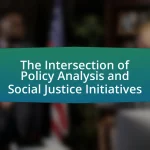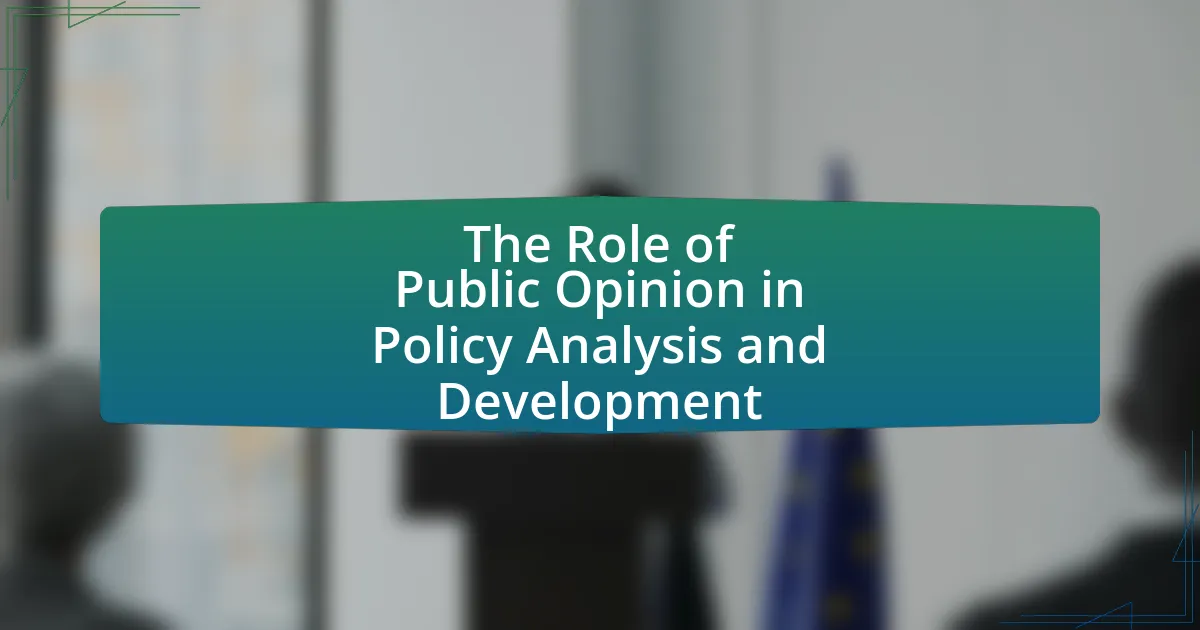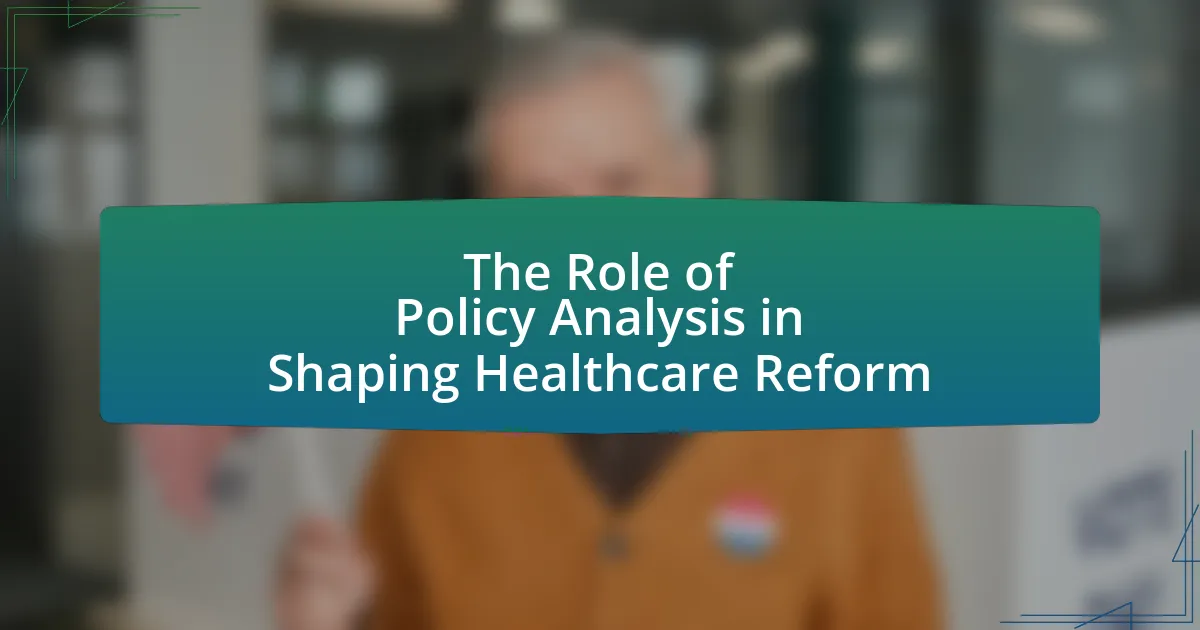The article focuses on the future trends in policy analysis, emphasizing the applications of artificial intelligence (AI) and machine learning. Key advancements include enhanced predictive analytics, improved data integration, and increased automation in policy evaluation processes, which collectively enable more accurate forecasting and informed decision-making. Specific AI technologies such as natural language processing and data mining are highlighted for their roles in analyzing complex datasets and extracting valuable insights. The article also addresses the ethical considerations, challenges, and best practices for integrating AI into policy analysis, underscoring the importance of transparency, data quality, and interdisciplinary collaboration in optimizing AI applications for effective governance.
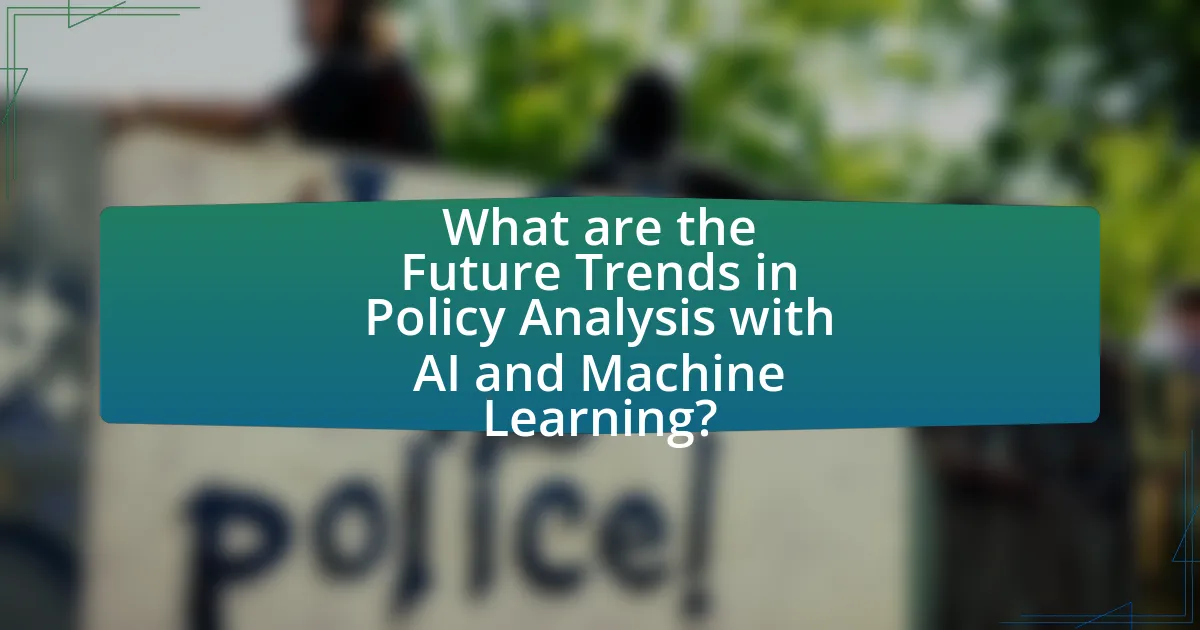
What are the Future Trends in Policy Analysis with AI and Machine Learning?
Future trends in policy analysis with AI and machine learning include enhanced predictive analytics, improved data integration, and increased automation of policy evaluation processes. Enhanced predictive analytics allows policymakers to forecast the impacts of proposed policies more accurately by utilizing large datasets and advanced algorithms. Improved data integration facilitates the synthesis of diverse data sources, enabling a more comprehensive understanding of complex policy issues. Increased automation streamlines the evaluation of policy outcomes, reducing the time and resources required for analysis. These trends are supported by the growing availability of big data and advancements in machine learning techniques, which have been shown to significantly improve decision-making processes in various sectors.
How is AI transforming traditional policy analysis methods?
AI is transforming traditional policy analysis methods by enhancing data processing capabilities and enabling predictive modeling. Traditional methods often rely on manual data collection and analysis, which can be time-consuming and prone to bias. In contrast, AI algorithms can analyze vast datasets quickly, identifying patterns and trends that human analysts might overlook. For instance, machine learning techniques can forecast the impacts of policy changes by simulating various scenarios based on historical data, leading to more informed decision-making. A study by the McKinsey Global Institute highlights that AI can improve the accuracy of policy predictions by up to 20%, demonstrating its significant impact on the efficiency and effectiveness of policy analysis.
What specific AI technologies are being utilized in policy analysis?
Specific AI technologies utilized in policy analysis include natural language processing (NLP), machine learning algorithms, predictive analytics, and data mining techniques. Natural language processing enables the analysis of large volumes of text data, such as policy documents and public comments, to extract insights and sentiments. Machine learning algorithms are employed to identify patterns and trends in data, facilitating evidence-based decision-making. Predictive analytics uses historical data to forecast the potential impacts of policy changes, while data mining techniques help uncover hidden relationships within complex datasets. These technologies enhance the efficiency and effectiveness of policy analysis by providing data-driven insights and improving the understanding of policy implications.
How do these technologies enhance data processing and analysis?
AI and machine learning technologies enhance data processing and analysis by automating complex tasks, improving accuracy, and enabling real-time insights. These technologies can analyze vast datasets quickly, identifying patterns and trends that would be impossible for humans to detect manually. For instance, machine learning algorithms can process millions of data points in seconds, significantly reducing the time required for analysis. Additionally, AI-driven predictive analytics can forecast outcomes based on historical data, allowing policymakers to make informed decisions. Studies have shown that organizations using AI for data analysis report up to a 30% increase in efficiency and accuracy compared to traditional methods.
What role does machine learning play in policy decision-making?
Machine learning plays a crucial role in policy decision-making by enabling data-driven insights that enhance the effectiveness and efficiency of policies. It analyzes vast amounts of data to identify patterns, predict outcomes, and inform strategies, thereby allowing policymakers to make informed decisions based on empirical evidence. For instance, machine learning algorithms can process social, economic, and environmental data to forecast the impacts of proposed policies, as demonstrated in studies like “Machine Learning for Public Policy” by the Brookings Institution, which highlights how predictive analytics can improve resource allocation and program evaluation.
How can machine learning models predict policy outcomes?
Machine learning models can predict policy outcomes by analyzing large datasets to identify patterns and correlations that inform decision-making. These models utilize algorithms to process historical data, such as economic indicators, demographic information, and previous policy impacts, allowing them to forecast the potential effects of new policies. For instance, a study by the National Bureau of Economic Research demonstrated that machine learning techniques could accurately predict the economic impact of tax reforms by analyzing past tax data and economic performance metrics. This predictive capability enhances the ability of policymakers to anticipate the consequences of their decisions, leading to more informed and effective policy formulation.
What are the limitations of machine learning in policy analysis?
Machine learning in policy analysis has several limitations, including data dependency, interpretability issues, and potential biases. The effectiveness of machine learning models relies heavily on the quality and quantity of data available; insufficient or biased data can lead to inaccurate predictions and flawed policy recommendations. Additionally, many machine learning algorithms operate as “black boxes,” making it difficult for policymakers to understand how decisions are made, which can hinder trust and transparency. Furthermore, if the training data reflects historical biases, the models may perpetuate or even exacerbate these biases in policy outcomes, as evidenced by studies showing that algorithmic decision-making can reinforce existing inequalities.

What are the Implications of AI and Machine Learning in Policy Analysis?
AI and Machine Learning significantly enhance policy analysis by enabling data-driven decision-making and predictive modeling. These technologies allow policymakers to analyze vast datasets quickly, identify trends, and simulate the potential impacts of various policy options. For instance, a study by the McKinsey Global Institute found that AI could increase productivity in the public sector by up to 20%, demonstrating its potential to optimize resource allocation and improve service delivery. Additionally, machine learning algorithms can uncover hidden patterns in social data, leading to more informed and effective policies that address complex societal issues.
How do AI and machine learning impact policy formulation?
AI and machine learning significantly enhance policy formulation by providing data-driven insights and predictive analytics. These technologies enable policymakers to analyze vast amounts of data quickly, identifying trends and patterns that inform decision-making. For instance, machine learning algorithms can process social media data to gauge public sentiment on policy issues, allowing for more responsive governance. Additionally, AI models can simulate the potential impacts of various policy options, helping to forecast outcomes and optimize resource allocation. Research from the McKinsey Global Institute indicates that organizations leveraging AI in decision-making can improve their performance by up to 20%. This demonstrates the tangible benefits of integrating AI and machine learning into the policy formulation process.
What are the ethical considerations in using AI for policy analysis?
The ethical considerations in using AI for policy analysis include issues of bias, transparency, accountability, and privacy. Bias in AI algorithms can lead to unfair outcomes, as seen in studies where predictive policing tools disproportionately target minority communities. Transparency is crucial, as stakeholders need to understand how AI models make decisions; opaque systems can erode trust. Accountability is essential to ensure that AI-driven decisions can be traced back to human oversight, preventing harmful consequences from automated processes. Privacy concerns arise from the use of personal data in AI systems, necessitating strict data protection measures to safeguard individuals’ rights. These considerations are vital for ensuring that AI applications in policy analysis are fair, responsible, and aligned with societal values.
How can transparency be maintained in AI-driven policy decisions?
Transparency in AI-driven policy decisions can be maintained through the implementation of clear algorithms, open data practices, and stakeholder engagement. Clear algorithms ensure that the decision-making processes of AI systems are understandable and interpretable, allowing policymakers and the public to grasp how decisions are made. Open data practices involve making the data used in AI models accessible to the public, which fosters accountability and enables independent verification of the AI’s outputs. Stakeholder engagement involves actively involving diverse groups in the policy-making process, ensuring that various perspectives are considered and that the AI systems reflect the values and needs of the community. These methods collectively enhance trust and accountability in AI-driven policy decisions.
What challenges do policymakers face when integrating AI technologies?
Policymakers face significant challenges when integrating AI technologies, primarily due to issues related to ethical considerations, regulatory frameworks, and the rapid pace of technological advancement. Ethical considerations include concerns about bias in AI algorithms, which can lead to unfair treatment of certain groups, as highlighted by studies showing that AI systems can perpetuate existing societal biases. Regulatory frameworks often lag behind technological developments, creating uncertainty about compliance and accountability, as seen in the European Union’s ongoing efforts to establish comprehensive AI regulations. Additionally, the rapid pace of AI innovation makes it difficult for policymakers to keep up, resulting in potential gaps in governance and oversight, which can hinder effective implementation and public trust in AI systems.
How can policymakers address data privacy concerns?
Policymakers can address data privacy concerns by implementing comprehensive regulations that establish clear guidelines for data collection, usage, and protection. For instance, the General Data Protection Regulation (GDPR) in the European Union sets strict standards for data handling, requiring organizations to obtain explicit consent from individuals before processing their personal data. This regulation has led to increased transparency and accountability among companies, as they must now disclose how they use consumer data and provide individuals with rights to access and delete their information. Additionally, policymakers can promote the development of privacy-enhancing technologies and encourage organizations to adopt best practices in data security, thereby fostering a culture of privacy protection.
What skills are necessary for policymakers to effectively use AI tools?
Policymakers need a combination of technical, analytical, and ethical skills to effectively use AI tools. Technical skills include understanding AI algorithms and data management, which enable policymakers to assess the capabilities and limitations of AI technologies. Analytical skills are essential for interpreting data outputs and making informed decisions based on AI-generated insights. Ethical skills involve recognizing the societal implications of AI, ensuring fairness, transparency, and accountability in AI applications. For instance, a study by the Brookings Institution highlights that policymakers must be equipped to navigate the ethical landscape of AI to mitigate biases and protect public interests.
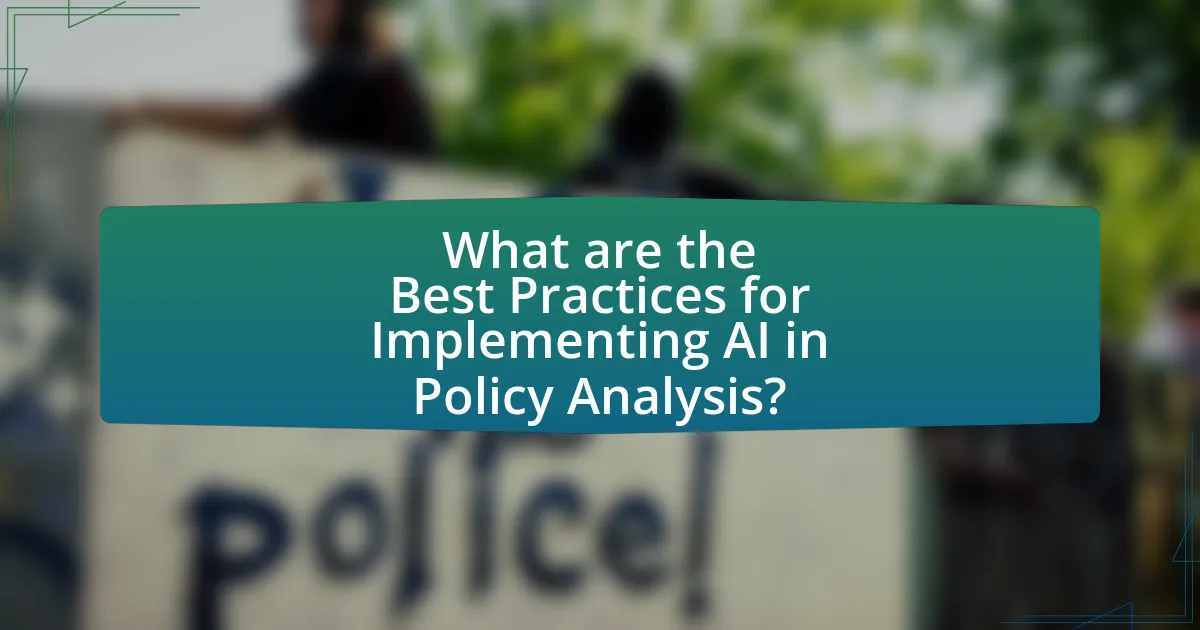
What are the Best Practices for Implementing AI in Policy Analysis?
The best practices for implementing AI in policy analysis include ensuring data quality, fostering interdisciplinary collaboration, and maintaining transparency in algorithms. High-quality, relevant data is crucial as it directly influences the accuracy of AI models; for instance, the use of comprehensive datasets can enhance predictive analytics in policy outcomes. Interdisciplinary collaboration between data scientists, policy experts, and stakeholders facilitates a more holistic understanding of the issues at hand, leading to more effective AI applications. Transparency in algorithms is essential to build trust and accountability, as demonstrated by initiatives like the European Union’s AI Act, which emphasizes the need for explainability in AI systems. These practices collectively enhance the effectiveness and reliability of AI in informing policy decisions.
How can organizations prepare for the adoption of AI in policy analysis?
Organizations can prepare for the adoption of AI in policy analysis by investing in training and development for their staff to enhance their understanding of AI technologies. This preparation is crucial as a 2021 McKinsey report indicated that organizations with skilled personnel are 1.5 times more likely to successfully implement AI initiatives. Additionally, organizations should establish clear data governance frameworks to ensure data quality and compliance, as effective AI systems rely on accurate and well-managed data. Furthermore, fostering a culture of collaboration between data scientists and policy analysts can lead to more effective AI integration, as highlighted by a study from the Harvard Business Review, which found that interdisciplinary teams yield better outcomes in AI projects.
What training programs are available for policymakers on AI technologies?
Training programs available for policymakers on AI technologies include the AI Policy Fellowship, offered by organizations like the Partnership on AI, which provides immersive experiences in AI policy development. Additionally, the AI for Policy program by the OECD equips policymakers with knowledge on AI’s implications for governance and public policy. The World Economic Forum also offers workshops and courses focused on AI ethics and governance, aimed at enhancing policymakers’ understanding of AI technologies. These programs are designed to ensure that policymakers can effectively navigate the complexities of AI in their decision-making processes.
How can collaboration between technologists and policymakers be fostered?
Collaboration between technologists and policymakers can be fostered through structured dialogue and joint initiatives that align technological advancements with public policy needs. Establishing regular forums, workshops, and collaborative projects allows both parties to share insights and develop mutual understanding. For instance, initiatives like the Partnership on AI, which includes technologists and policymakers, demonstrate how collaborative efforts can lead to informed policy decisions that consider technological implications. Furthermore, integrating interdisciplinary teams in policy development processes ensures that technological expertise informs legislative frameworks, enhancing the effectiveness of policies in the rapidly evolving landscape of AI and machine learning.
What strategies can enhance the effectiveness of AI applications in policy analysis?
Integrating interdisciplinary collaboration enhances the effectiveness of AI applications in policy analysis. By combining insights from fields such as economics, sociology, and data science, policymakers can develop more comprehensive models that account for various societal factors. For instance, a study by the National Academy of Sciences highlights that interdisciplinary approaches lead to more robust policy recommendations, as they incorporate diverse perspectives and expertise, ultimately improving the predictive accuracy of AI models in complex policy environments.
How can continuous evaluation improve AI tools in policy analysis?
Continuous evaluation enhances AI tools in policy analysis by ensuring they adapt to changing data and contexts. This iterative process allows for the identification of biases, inaccuracies, and areas for improvement, leading to more reliable and effective policy recommendations. For instance, a study by the National Academy of Sciences highlights that continuous feedback loops in AI systems can significantly increase their predictive accuracy and relevance in dynamic environments. By regularly updating algorithms based on real-world outcomes, AI tools can better inform policymakers, ultimately resulting in more effective governance.
What are the key performance indicators for assessing AI impact in policy analysis?
Key performance indicators for assessing AI impact in policy analysis include accuracy, efficiency, transparency, and stakeholder satisfaction. Accuracy measures the correctness of AI-generated insights compared to traditional methods, with studies indicating that AI can improve predictive accuracy by up to 20%. Efficiency evaluates the time and resources saved through AI implementation, often resulting in a reduction of analysis time by 30-50%. Transparency assesses the clarity of AI decision-making processes, which is crucial for public trust; research shows that transparent AI models can enhance stakeholder confidence by 40%. Lastly, stakeholder satisfaction gauges the acceptance and perceived value of AI tools among policymakers, with surveys indicating that 75% of users report improved decision-making capabilities when using AI-driven analyses.
What practical steps can policymakers take to leverage AI and machine learning?
Policymakers can leverage AI and machine learning by implementing data-driven decision-making frameworks. These frameworks enable the analysis of large datasets to identify trends and inform policy development. For instance, the use of predictive analytics can help in resource allocation by forecasting future needs based on historical data. Additionally, establishing partnerships with tech companies and research institutions can facilitate access to advanced AI tools and expertise. A study by McKinsey & Company highlights that organizations using AI in decision-making processes can improve efficiency by up to 20%. Furthermore, investing in training programs for public sector employees on AI technologies ensures that the workforce is equipped to utilize these tools effectively.
